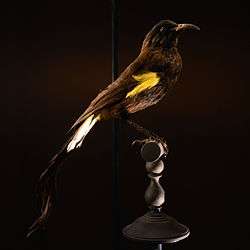Hawaiʻi ʻōʻō
| Hawaiʻi ʻōʻō | |
|---|---|
 | |
| Stuffed specimen | |
| Scientific classification | |
| Kingdom: | Animalia |
| Phylum: | Chordata |
| Class: | Aves |
| Order: | Passeriformes |
| Suborder: | Passeri |
| Infraorder: | Passerida |
| Family: | † Mohoidae |
| Genus: | † Moho |
| Species: | † M. nobilis |
| Binomial name | |
| Moho nobilis Merrem, 1786 | |
The Hawaiʻi ʻōʻō (Moho nobilis) is a member of the extinct genus of the ʻōʻōs (Moho) within the extinct family Mohoidae. It was previously regarded as member of the Australo-Pacific honeyeaters (Meliphagidae).[2]
Description


The Hawaiʻi ʻōʻō was first described by Blasius Merrem in 1786. It had an overall length of 32 centimetres (13 in), wing length of 11–11.5 centimetres (4.3–4.5 in), and tail length of up to 19 centimetres (7.5 in). The colour of its plumage was glossy black with a brown shading at the belly. It was further characterized by yellowish tufts at the axillaries. It had some yellowish plumes on its rump, but lacked yellow thigh feathers like the Bishop's ʻōʻō, and also lacked the whitish edgings on its tail feathers like the Oʻahu ʻōʻō. However it had the largest yellow plumes on its wings out of all the species of ʻōʻō.
Extinction
At the time of discovery by Europeans, it was still relatively common on the Big Island, but that was soon to change. The Hawaiʻi ʻōʻō feathers were carefully plucked as they only removed a few a time and then the bird was released by Native Hawaiians. Its striking plumage was used for ʻaʻahu aliʻi (robes), ʻahu ʻula (capes), and kāhili (feathered staffs) of aliʻi (Hawaiian nobility). The Europeans too saw the striking beauty of this bird and hunted many of them for specimens in personal collections. Some were even caught and put in cages to be sold as song birds only to live for a few days or weeks before diseases from mosquitoes befell them. The decline of this bird was hastened by both natives and Europeans by the introduction of the musket which allowed hunter and collectors to shoot birds down from far away places, from great heights, and in great numbers. As late as 1898, hunters were still able to kill over a thousand of the birds, but after that year the ʻōʻō population declined rapidly.[3] The birds became too rare to be shot in any great quantities, but continued to be found for nearly 30 years. The last known sighting was in 1934 on the slopes of Mauna Loa.
See also
- The name of the volcano Puʻu ʻŌʻō is often translated as "Hill of the ʻŌʻō-Bird", referring to this species.
References
- ↑ BirdLife International (2012). "Moho nobilis". IUCN Red List of Threatened Species. Version 2013.2. International Union for Conservation of Nature. Retrieved 26 November 2013.
- ↑ Fleischer, Robert C.; Helen F. James; Storrs L. Olson (2008-12-11). "Convergent Evolution of Hawaiian and Australo-Pacific Honeyeaters from Distant Songbird Ancestors". Current Biology. Cell Press. 18 (24): 1927–1931. doi:10.1016/j.cub.2008.10.051. PMID 19084408.
- ↑ Henshaw, HW (1902) Birds of the Hawaiian Islands, p. 71.
External links
- 3D view of specimens RMNH 110.044 and RMNH 110.045 (formerly RMNH 2142) at Naturalis, Leiden (requires QuickTime browser plugin).
